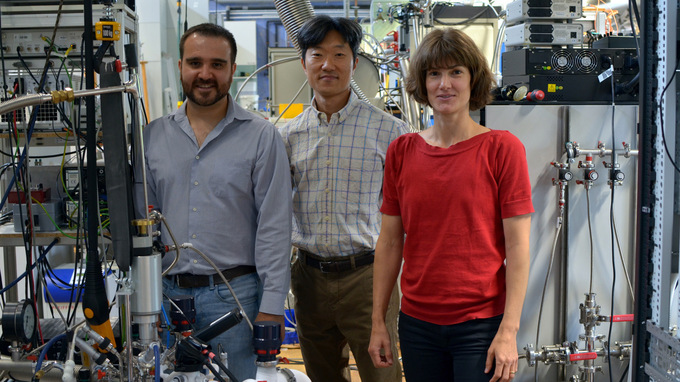Ungewöhnliche Supraleitung mit zwei Phasen
Neuer Schwerer Fermion-Supraleiter zeigt überraschende Eigenschaften
2021-08-29 – Nachrichten aus dem Physik-Department

Symmetrie und Symmetriebrechung sind Schlüssel zu vielen interessanten Phänomenen in der Physik der kondensierten Materie. Herkömmliche, also durch Phonon-Elektron-Kopplung hervorgerufene Supraleitung erfordert zum Beispiel sowohl Zeitumkehr als auch Inversionssymmetrie, und die Entfernung einer davon - wie die Zeitumkehr durch ein Magnetfeld - führt zur Unterdrückung der supraleitenden Ordnung.
Seit 2004 sind nicht-zentrosymmetrische Supraleiter interessant geworden, wobei die fehlende Inversionssymmetrie zu einer Vermischung von Spin-Singulett- und Spin-Triplett-Cooper-Paaren in der supraleitenden Phase führt. Tatsächlich sind diese Supraleiter aufgrund der starken Spin-Bahn-Kopplungseffekte, die aufgrund der gebrochenen Inversionssymmetrie entstehen, sehr robust gegen das Anlegen eines Magnetfelds.
Phasenübergang bei 4 T
Nun berichten Wissenschaftler vom Max-Planck-Institut für Chemische Physik fester Stoffe, der Technischen Universität München sowie internationalen Forschungseinrichtungen von der Messung einer zweiphasigen unkonventionellen Supraleitung in CeRh\(_2\)As\(_2\), einem neuen Schwere Fermion-Supraleiter. Die Forscher konnten im supraleitenden Zustand einen internen Phasenübergang bei etwa 4 T messen, wenn das Magnetfeld in Richtung kristallographischer c-Achse angelegt wird. Ein solcher Phasenübergänge bei Umgebungsdruck ist bislang extrem selten beobachtet worden und nur von UPt\(_3\) bekannt. Dieser exotische Supraleiter zeigt drei supraleitende Phasen bei verschiedenen Temperaturen und Magnetfeldern, deren Herkunft aber unklar ist.
„Wir vermuten, dass unsere Beobachtungen in CeRh\(_2\)As\(_2\) auf eine andere Physik zurückzuführen sind als in UPt\(_3\)“, sagt Elena Hassinger, Professorin für experimentelle Festkörperphysik an der TUM und Forschungsgruppenleiterin am Max-Planck-Institut für Chemische Physik fester Stoffe in Dresden. „Die wichtigsten supraleitenden Eigenschaften von CeRh\(_2\)As\(_2\) sind wahrscheinlich eine Manifestation der lokalen Inversionssymmetriebrechung und der daraus resultierenden Rashba-Spin-Bahn-Kopplung in einer insgesamt inversionssymmetrischen Kristallstruktur.“
Lokale Symmetriebrechung als Ursache vermutet
Obwohl CeRh\(_2\)As\(_2\) zentrosymmetrisch mit Inversionssymmetrie ist, weist das Material lokal eine Nicht-Zentrosymmetrie mit einer Inversionssymmetrie auf, welche zwei nicht zentrosymmetrische Ce-Würfelgitter verbindet, jede mit einer Rashba-Wechselwirkung. „Man könnte sich das wie ein Doppelschichtsystem vorstellen, bei dem es zu einem Zusammenspiel zwischen der Rashba-Wechselwirkung innerhalb einer Schicht und einem Hopping zwischen den Schichten kommt. Im Niederfeldzustand hat die Supraleitung gerade Parität, das Vorzeichen der Wellenfunktion ist also in diesen beiden Ce-Schichten gleich, während der Hochfeldzustand ungerade Parität mit wechselndem Vorzeichen in den Ce-Schichten hat.“
Auch die ungewöhnliche Richtungsabhängigkeit des kritischen Magnetfeldes in CeRh\(_2\)As\(_2\) passt für die Forscher in dieses Bild. In Richtung der kristallographischen c-Achse zeigt das Material bei einer Übergangstemperatur von nur 0,26 K ein extrem hohes kritisches Feld (14 T), weit größer als in der Grundebene (1,9 T).
„Unsere Beobachtungen, die wahrscheinlich aus der lokalen Umgebung von Ce resultieren, legen nahe, dass CeRh\(_2\)As\(_2\) zukünftig ein Referenzmaterial sein wird, um den Einfluss der Spin-Bahn-Kopplung auf elektronische Mechanismen für unkonventionelle Supraleiter zu untersuchen“, sagt Elena Hassinger.
- Redaktion
- Petra Riedel
Veröffentlichung
Weitere Informationen
An der Studie waren Wissenschaftlerinnen und Wissenschaftler folgender Institutionen beteiligt: Max-Planck-Institut für Chemische Physik fester Stoffe, Dresden; Universität Otago, Neuseeland; Universität St. Andrews, Großbritannien; Universität Wisconsin-Milwaukee und Technische Universität München. In Deutschland wurde die Arbeit finanziell unterstützt von der Max-Planck-Gesellschaft und der Deutschen Forschungsgemeinschaft.